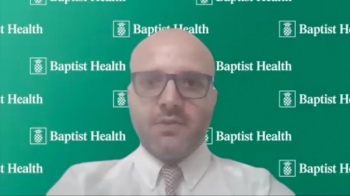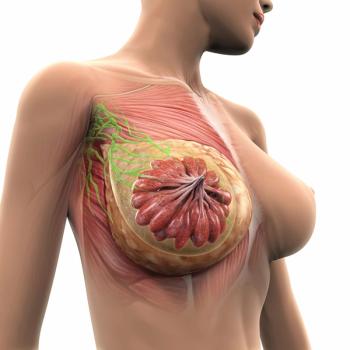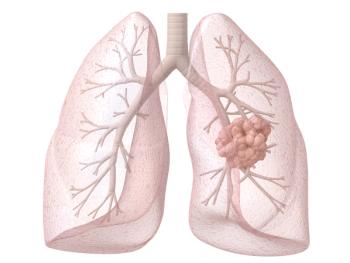
Sacituzumab Tirumotecan Improves Survival in Second-Line EGFR+ NSCLC
OptiTROP-Lung04 data show sacituzumab tirumotecan cut the risk of progression or death by 51% in patients with nonsquamous EGFR-mutated NSCLC resistant to EGFR TKIs.
Sacituzumab tirumotecan (sac-TMT) led to a 51% reduction in the risk of death progression or death compared with chemotherapy in patients with nonsquamous EGFR-mutated non–small cell lung cancer (NSCLC) that developed EGFR tyrosine kinase inhibitor (TKI) resistance, according to phase 3 results of the OptiTROP-Lung04 study (NCT05870319) that were presented during the
Results showed that, at a median follow-up of 18.9 months, the median progression-free survival (PFS) via blinded independent central review (BICR) was 8.3 months (95% CI, 6.7-9.9) with sac-TMT and 4.3 months (95% CI, 4.2-5.5) with chemotherapy (HR, 0.49; 95% CI, 0.39-0.62; P < .0001). The 12-month PFS rates were 32.3% (25.5%-39.2%) and 7.9% (95% CI, 4.4%-12.8%), respectively. The PFS benefit with sac-TMT was observed across all prespecified subgroups.
The investigator-assessed median PFS was 8.4 months (95% CI, 7.1-9.7) with sac-TMT and 4.8 months (95% CI, 4.2-5.5) with chemotherapy (HR, 0.51; 95% CI, 0.41-0.65; P < .0001). The 12-month PFS rates were 34.7% (27.7%-41.7%) and 10.7% (95% CI, 6.5%-16.0%), respectively.
“Sac-TMT demonstrated statistically significant and clinically meaningful improvements in PFS and OS compared with platinum-based chemotherapy,” lead study author Li Zhang, MD, professor of medical oncology at Sun Yat-sen University Cancer Center in Guangzhou, China, said in an oral presentation of the data. “The results of the OptiTROP-Lung04 study support sac-TMT as a promising new treatment option for patients with EGFR-mutated NSCLC with EGFR TKI resistance.”
Sac-TMT is a TROP2 antibody-drug conjugate (ADC) with a unique biofunctional linker that maximizes delivery of a belotecan-derivative topoisomerase type I inhibitor payload to tumor cells. TROP2 is highly expressed in patients with EGFR-mutated NSCLC; preclinical data have shown that sac-TMT internalization and uptake are enhanced by EGFR mutations.2
The current standard option for patients who experience relapse on third-generation EGFR TKIs remains platinum-based chemotherapy, but more options are needed.
In the multicenter, open-label, phase 3 OptiTROP-Lung04 trial, 376 patients with nonsquamous stage IIIB/IIIC or IV NSCLC with EGFR-sensitive mutations were randomly assigned 1:1 to receive sac-TMT at 5 mg/kg intravenously every 2 weeks or pemetrexed at 500 mg/m2 plus carboplatin area under the curve 5 or cisplatin at 75 mg/m2 every 3 weeks for up to 4 cycles, followed by pemetrexed maintenance at 500 mg/m2 every 3 weeks. Treatment was given until disease progression, intolerable toxicity, or patient request to discontinue therapy.
To be eligible for enrollment, patients needed to have an ECOG performance status of 0 or 1 and progression after third-generation TKI therapy or progression after first- or second-generation TKIs with T790M-negative mutations.
Stratification factors included prior EGFR TKI therapy (third-generation TKI in frontline vs second line vs no third-generation TKI) or brain metastases (yes vs no).
The primary end point was PFS assessed by BICR; secondary end points were overall survival (OS), investigator-assessed PFS, objective response rate (ORR), disease control rate (DCR), duration of response (DOR), and safety.
A total of 148 patients on sac-TMT discontinued treatment due to disease progression (n = 125), patient or guardian withdrawal (n = 12), death (n = 6), adverse effects (AEs; n = 2), or other reason (n = 3). In the chemotherapy arm, 179 patients discontinued treatment due to disease progression (n = 140), patient/guardian withdrawal (n = 16), death (n = 9), AEs (n = 5), protocol deviation (n = 2), or other reason (n = 7). A total of 69 and 102 patients in each arm, respectively, discontinued the study due to death (n = 67 and 101) or were lost to follow-up (n = 2 and 1).
The data cutoff date was July 6, 2025.
Patient baseline characteristics were generally well-balanced between the sac-TMT (n = 188) and chemotherapy arms (n = 188). The median age was 60 years (range, 31-75) and 59 years (range, 33-75), and 30.9% and 27.1%, respectively, were at least 65 years old. Most had an ECOG performance status of 1 (81.4% and 77.1%), had no smoking history (77.1% and 71.8%), had stage IV disease (96.8% and 98.4%), and had at least 3 metastatic sites (68.1% and 67.0%). A total of 17.6% and 19.1% had brain metastases, and 13.3% and 17.6% had liver metastases. The majority in each arm had exon 19 deletions (56.4% and 62.8%), had unknown T790M mutation status (59.0% and 59.6%), and received a prior third-generation EGFR TKI in the frontline setting (62.8% and 62.2%).
The interim analysis showed that for sac-TMT, the median OS was not reached (95% CI, 21.5-not estimable) compared with 17.4 months (95% CI, 15.7-20.4) with chemotherapy, leading to a 40% reduction in the risk of death (HR, 0.60; 95% CI, 0.44-0.82; 2-sided P = .001). The 18-month OS rates were 65.8% (95% CI, 58.3%-72.3%) and 48.0% (95% CI, 40.2%-55.4%), respectively. OS was improved with sac-TMT across all prespecified subgroups.
Zhang also reported on subsequent anticancer treatment from the trial; 72.3% of patients on sac-TMT and 85.5% of those on chemotherapy received at least 1 subsequent treatment. In the sac-TMT and chemotherapy groups, respectively, these were comprised of chemotherapy (41.9%; 53.6%), and specifically pemetrexed-based chemotherapy (37.2%; 12.8%), an EGFR TKI (42.6%; 39.7%), an antiangiogenic agent (34.5%; 48.0%), immunotherapy (16.9%; 24.6%), or an ADC (1.4%; 19.6%).
Additionally, when censoring patients at the time of initiation of subsequent ADCs, sac-TMT significantly improved OS vs chemotherapy (HR, 0.56; 95% CI, 0.41-0.77).
When assessed via BICR, the ORR with sac-TMT was 60.6% (95% CI, 53.3%-67.7%) compared with 43.1% (95% CI, 35.9%-50.5%) with chemotherapy; the DCR was 87.2% (95% CI, 81.6%-91.6%) and 80.3% (95% CI, 73.9%-85.7%), respectively. The median DOR was 8.3 months (95% CI, 6.2-10.0) with sac-TMT and 4.2 months (95% CI, 3.0-4.4) with chemotherapy; the 12-month DOR rates were 36.3% (95% CI, 27.3%-45.3%) and 8.1% (95% CI, 3.3%-15.8%), respectively.
Regarding safety, treatment-related AEs (TRAEs) occurred in 100% and 98.4% of sac-TMT– and chemotherapy-treated patients, respectively. Grade 3 or higher TRAEs occurred in 58.0% and 53.8% of patients, and serious TRAEs occurred in 9.0% and 17.6% of patients, respectively. TRAEs that led to dose reductions and interruptions occurred in 30.3% and 36.7% of patients on sac-TMT; there were no TRAEs that led to discontinuation or death. In the chemotherapy arm, these rates were 22.5% and 33.0%; 1 patient each experienced TRAEs leading to discontinuation or death.
The median duration of exposure was 9.6 months (range, 0.5-23.5) with sac-TMT and 4.9 months (range, 0.7-22.6) with chemotherapy.
The most common TRAEs in both arms were hematologic events; sac-TMT had higher incidence of stomatitis that was mostly grade 1/2 (any-grade, 62%; grade ≥ 3, 5%). Ocular surface toxicities also occurred in 9.6% of patients on sac-TMT, which were all grades 1/2. No cases of interstitial lung disease or pneumonitis were reported in the sac-TMT arm.
Phase 3 trials are currently exploring sac-TMT alone (NCT06305754; NCT06074588) and in combination with osimertinib (Tagrisso; NCT06670196) in patients with EGFR-mutant NSCLC.
Disclosures: Zhang cited personal declaration of interests with Akesobio and Sichuan Biokin Pharmaceutical as an invited speaker and cited an institutional declaration of interests with Akesobio as trial chair, AstraZeneca as research grant recipient and trial chair, China Shiyao Pharma as trial chair, Hengrui Pharma as trial chair, Kelun Pharmaceutical as trial chair, Novartis as trial chair, Pfizer as trial chair, Pierre Fabre as trial chair, Qilu Pharmaceutical as trial chair, Roche as research grant recipient, and Sichuan Biokin Pharmaceutical as trial chair.
References
- Zhang L, Fang W, Wu L, et al. Sacituzumab tirumotecan (sac-TMT) vs platinum-based chemotherapy in EGFR-mutated (EGFRm) non-small cell lung cancer (NSCLC) following progression on EGFR-TKIs: results from the randomized, multi-center phase 3 OptiTROP-Lung04 study. Abstract presented at: European Society for Medical Oncology Congress 2025; October 17-21, 2025; Berlin, Germany. Abstract LBA5.
- Zhao S, Cheng Y, Wang Q, et al. Sacituzumab tirumotecan in advanced non-small-cell lung cancer with or without EGFR mutations: phase 1/2 and phase 2 trials. Nat Med. 2025;31(6):1976-1986. doi:10.1038/s41591-025-03638-2
Newsletter
Stay up to date on recent advances in the multidisciplinary approach to cancer.



















































































